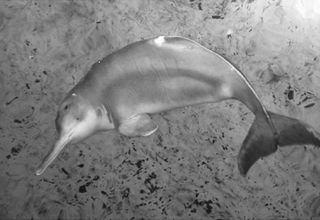
Conserving Life Along China's Yangtze River (Op-Ed)

Nick Conger is former editor of the World Wildlife Fund (WWF) blog, On Balance. This article was adapted from his post Conserving Life Along the Yangtze. Conger contributed this article to LiveScience's Expert Voices: Op-Ed & Insights.
In late 2006, researchers from the Institute of Hydrobiology at the Chinese Academy of Sciencesin Wuhan, China returned from a six-week journey on the Yangtze River, dejected.
They had searched far and wide for signs of the baji — commonly known as the "Goddess of the Yangtze," China's famed river dolphin — and came up empty. Months later the freshwater species was declared functionally extinct.
Years of rapid industrial growth coupled with unsustainable practices had destroyed its natural habitat. It was the first species of dolphin whose demise was directly attributable to human influence.
Today, World Wildlife Fund and its partners in Wuhan are doing all they can to save the baji's cousin — the finless porpoise— from the same fate. Estimates suggest that only about 1,000 remain in the wild.
In doing this, we also are working on a much broader goal: conserving the Yangtze itself. In protecting the habitat of the smiley creature, we also are supporting sustainable fishing practices that will enhance the country's food supply and continue to bolster its gross domestic product.
We're using conventional methods, such as reconnecting floodplain lakes with the main stem of the Yangtze to restore seasonal flows — allowing for migrations between the lakes and the river — as well as applying some unconventional methods, too.
Sign up for the Live Science daily newsletter now
Get the world’s most fascinating discoveries delivered straight to your inbox.
Conserving the Yangtze is important, regardless of whether you're a businessperson, investor or eco-conscious consumer. The Yangtze River Delta generates more than 70 percent of the fish consumed in China, more than 20 percent of its agriculture and as much as 20 percent of China's gross domestic product. Frontier Economics recently estimated that the river itself could generate as much as 7.8 percent of global GDP by 2050. The river is also the source of copious amounts of minerals, and energy in the form of hydro-electric power.
Paradoxically, the same interests that benefit from the Yangtze are destroying it. CNN recently reported that about 800 million tons of wastewater is dumped into the Yangtze every year. Such pollution combined with overfishing (which, incidentally, threatens food supplies for the finless porpoise, among other species ), jeopardizes the long-term viability of the Yangtze and those who rely on it.
That's why WWF also is using unconventional approaches, working with local fishermen and business. Central to this strategy in China is sustainable aquaculture, the fastest-growing food-producing sector in the world. China is the source of more than 60 percent of the world's aquaculture, most of which stays in-country (about one third of all the animal protein the Chinese eat comes from farmed-raised fish).
WWF and its partners at the Institute of Hydrobiology in Wuhan have helped establish 50 "eco-fisheries" in lakes along the Yangtze, working with fishermen, local government authorities and retailers to source and produce a variety of fish (such as the popular mandarinfish) and crustaceans more sustainably.
While pursuit of the newly established Aquaculture Stewardship Council certification is still an aspirational goal, the project is helping those fisheries secure the coveted organic label in China by phasing out artificial fish feed, eliminating harmful fertilizers and clearing away boundaries between lakes and the river — all with an eye toward maintaining fish stocks for the future.
In those 50 eco-fishery lakes, Institute of Hydrobiology research professor Liu Jiashou has seen improvements in water quality and biodiversity, not to mention improved economic conditions for the fishermen.
"The traditional practices would result in destroying the environment," Liu says. "But [with increased demand], the farmers cannot stop farming, so the only way we can help is to change the methods. Aquaculture has become the best way to have both intensive production and to control pollution at the same time."
The 50 eco-fisheries will not alone save the finless porpoise. But, there are plans to establish another 300 in the next decade. As eco-fisheries grow, WWF and the Institute of Hydrobiology are confident they will help curtail overfishing, reduce pollution in the water and maintain fish stocks. This will reduce stress on this critical basin upon which economic growth is so dependent.
Lives are at stake — whether it's marine species, or the people who depend on the river for food and income. We can't afford to come up empty.
The views expressed are those of the author and do not necessarily reflect the views of the publisher. This article was originally published on LiveScience.com.
